Hotel Chancellor
Introduction
Text-to-speech Audio
The large building on 7th St. northwest of the intersection with S. Bernardo St. was the Hotel Chancellor when it was first built in 1924. Now The Chancellor Apartments, the historic building was added to the National Register of Historic Places in 2006 as an example of dense residential development in the Wilshire Boulevard area.The architect for the five-story Beaux Arts style building was Milton M. Friedman. The exterior of the U-shaped structure was cast concrete on the ground level, with a smooth or a rusticated surface. The bricks on the upper four floors were painted and the corner quoins were cast concrete. A large, illuminated sign atop the southeast corner of the building faced southeast and was built on a steel framework in 1925.
Images
Hotel Chancellor in 2008 photo with "For Lease" sign on front corner (user: Los Angeles)
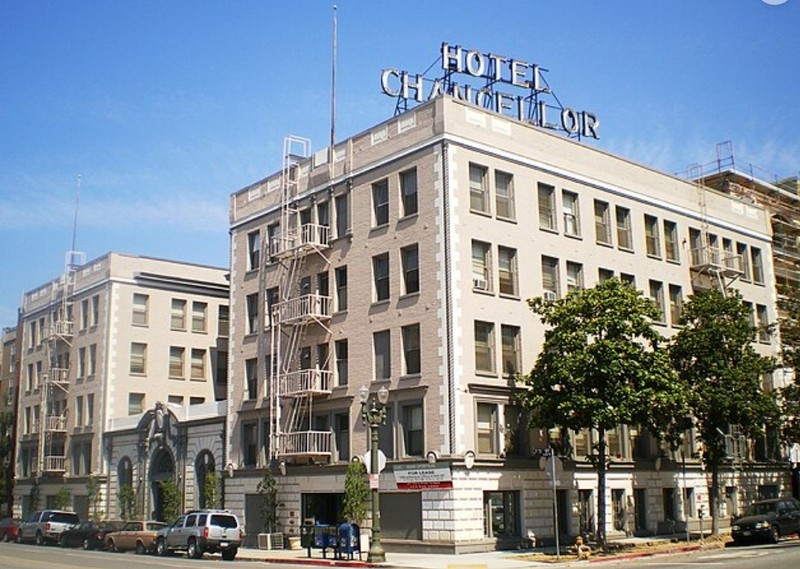
Front of Hotel Chancellor in 2005 photo for NRHP nomination (Carly Caryn)
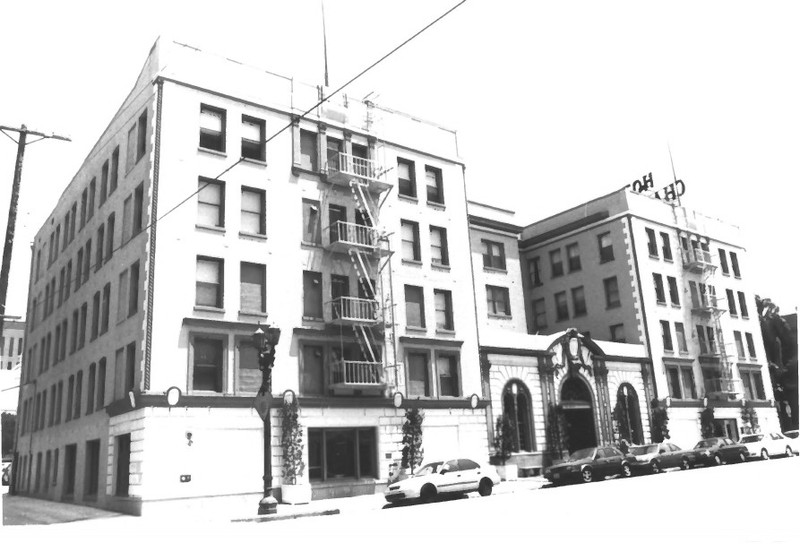
Detail of central entrance to Hotel Chancellor building in 2005 (Carly Caryn)
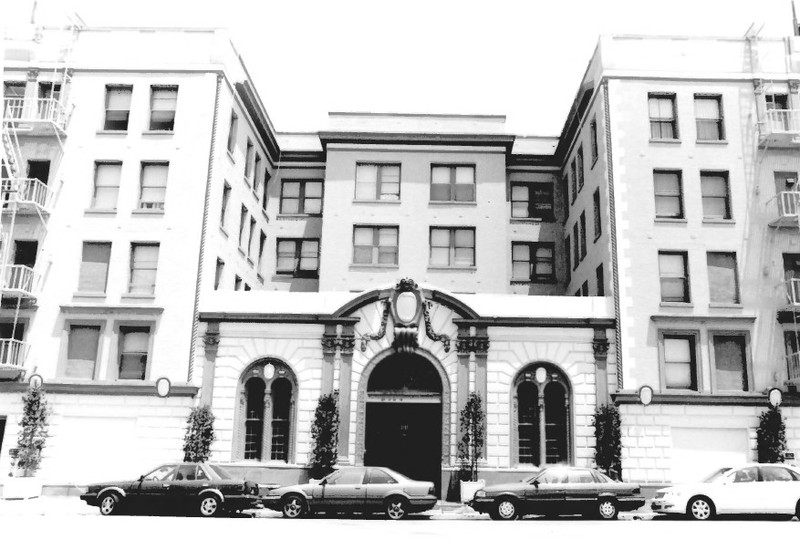
Back of Hotel Chancellor sign from rooftop of east wing (Carly Caryn 2005)
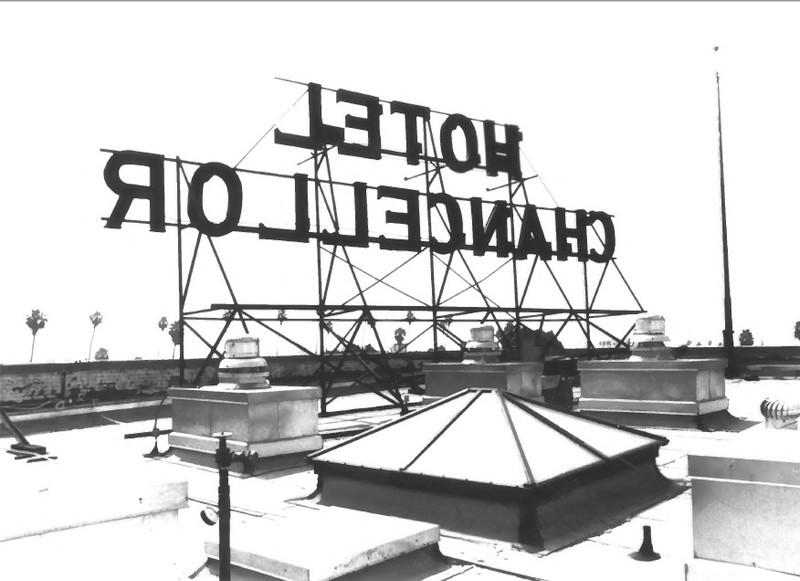
Vintage linen postcard of Hotel Chancellor from the 1930s or 1940s; parapet wall decoration intact
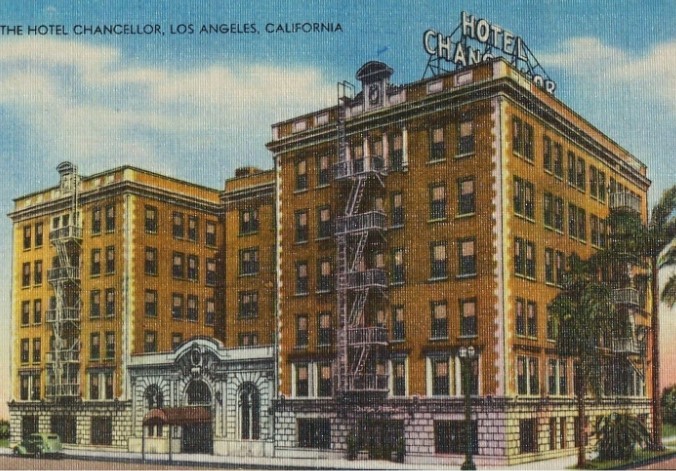
Lobby of Chancellor Apartments, looking out through main entrance (Carly Caryn 2005)

View from lobby to elevator and stairway to wing in Chancellor Apartments (Carly Caryn 2005)
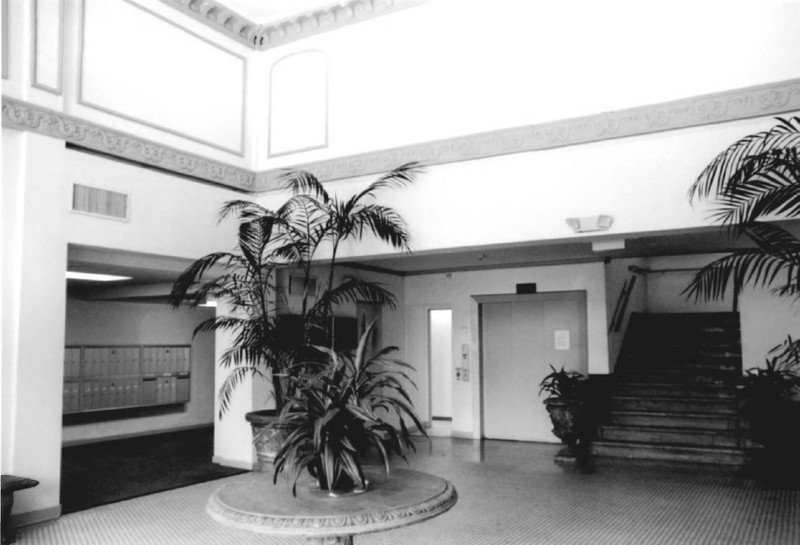
1949 newspaper ad for The Cove lounge in hotel with Romanoff caviar served during cocktail hour (Hotel Chancellor)
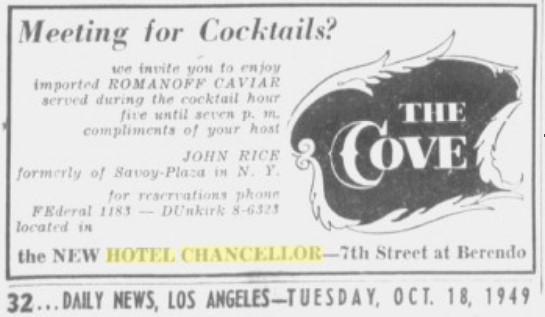
Backstory and Context
Text-to-speech Audio
Hotel Chancellor was built in 1924, west of downtown Los Angeles. This part of the city became especially popular for building multi-story hotels and apartment buildings in the 1910s and 1920s. The architect for the five-story Beaux Arts style building was Milton M. Friedman. The exterior of the U-shaped structure was cast concrete on the ground level, with a smooth or a rusticated surface. The bricks on the upper four floors were painted and the corner quoins were cast concrete. A tall, one-story section connected the wings by the front sidewalk along W. Seventh Street, with a triple-arched design formed by two windows and a central entrance beneath a decorative garland and cartouche. Concrete parapets atop the east and west wings framed a flat roof; the center of each parapet wall once contained a decorative pediment that was removed by the 2000s. A large, illuminated sign atop the southeast corner of the building faced southeast and was built on a steel framework in 1925. Just one year earlier, the country's first neon sign was installed at the Packard car dealership at Wilshire Boulevard and La Brea in L.A.
Public areas of the hotel were the lobby, a lounge/restaurant, and a ballroom/banquet hall on the first floor and the partial basement. The upper floors held 114 hotel rooms originally. Hotel Chancellor was not the fanciest of the new hotels and apartment buildings in the area, with rooms on the small side. The location was convenient, though, being just one block off of Wilshire Boulevard. Newspapers touted the neighborhood as a fashionable apartment district.
Chancellor Hotel was operated by George E. Goldberg, head of the Midwest Hotel Company, by 1952. Goldberg sold a ten-year lease for the hotel and another nearby (Ashley Arms at Wilshire Blvd. and Warren Ave.) in 1952 for a million dollars to a Seattle couple, Mr. and Mrs. David Dover. The hotel advertised its rates in June 1953 as two dollars per day for monthly rentals and up, with weekly rates as well. The hotel offered daily maid service, free television, a 24-hour switchboard, and plentiful parking. The aging hotel was located in a neighborhood that became known as Koreatown, after an influx of South Korean immigrants in the 1960s. The hotel's first major restoration was done in the 1960s, with interior changes to the ground level spaces made in the 1980s. Now affordable apartments, Chancellor Apartments underwent rehabilitation in the early 2000s; the hexagonal tile floors, marble stairs in the lobby, and crown moldings were restored. The structure also became a 106-unit building so that some of the rooms could be enlarged.
Sources
Anonymous. "Million-Dollar Hotel Lease Bared." Daily News (Los Angeles) December 1st, 1952. 10-10.
Hotel Chancellor. "$2 Day Up by Mo.." Daily News (Los Angeles) June 9th, 1953. Classifieds sec, 28-28.
McAvoy, Christy Johnson. Ritz, Jessica N. NRHP nomination of Hotel Chancellor, Los Angeles, California. National Register. Washington, DC. National Park Service, 2005.
https://en.wikipedia.org/wiki/Hotel_Chancellor#/media/File:Hotel_Chancellor,_Los_Angeles.JPG
National Park Service (NPS): https://npgallery.nps.gov/AssetDetail/NRIS/05001496
NPS: https://npgallery.nps.gov/AssetDetail/NRIS/05001496
NPS: https://npgallery.nps.gov/AssetDetail/NRIS/05001496
https://www.ebay.com
NPS: https://npgallery.nps.gov/AssetDetail/NRIS/05001496
NPS: https://npgallery.nps.gov/AssetDetail/NRIS/05001496
Daily News (Los Angeles), October 18th, 1949, p. 10
